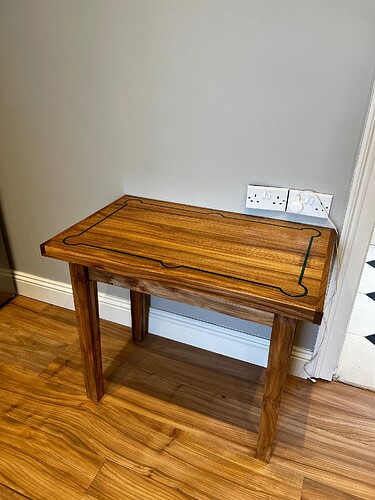First attempt at this. We previously milled up an old elm tree for floorboards and I used some leftovers for this table. I used the Shapeoko to flatten the top and insert a channel in which to pour some epoxy. I learned:
The top (specifically the channel) as to be absolutely gravitationally level so the epoxy flows evenly - CNC is therefore great but you have to make sure your Shapeoko is also level!
For flattening, I used a little 1 inch surface bit which burned a black streak regardless of speed. I tried a fresh bit and slowed down the router speed to its lowest speed and the burning stopped. I manually drew a polyline and had the Shapeoko follow the line.
Nice table. I do epoxy inlay on a lot of projects. I use MAS table top epoxy which can do to 1/4" deep. I put painters tape around the boundary of the epoxy pour and crimp up the inside edge. The MAS is thick enough to not run too much but the tape stops it likely due to surface tension. I use a heat gun to pop the bubbles and that will spread the fresh epoxy. The tape stops the spread and comes off easily once the epoxy is cured. Always overfill epoxy because it shrinks slightly when curing. So if you pour it just to the top you will have the epoxy lower than the surface. The MAS is usually to machine overnight. You always want your surface level when pouring epoxy so it does not run like a water fall all over everything. Maybe flatten both sides but work benches are seldom level and you can shim the material before pouring. The deep pour stuff is just like water and will go every where. For that I use Tyvek tape because the epoxy does not stick to it.
A few people here on the forum have suggested running your epoxy through the planner to remove excess epoxy. That works but always stop before you get to the wood. The planner is very violent and does not like epoxy. I usually just run mine through a drum sander. If you dont have a drum sander then just some 60/80/120/150/220 grit paper in a random orbit sander will work. The 60/80 will clog up from the epoxy but after that it is just normal sanding. You do not have to go to high grits for the epoxy because your finish will brighten it up from dull as dishwater to as shinny as your finish.
I do not know this to be true but I have had people tell me that elm stinks when you use it for firewood.
Nice. Where did you get your Elm from?
Elm is very beautiful. However people have told me that if you burn elm in a fireplace/stove it is very smelly. Does anyone know if that is true?
Don’t know, I am inside enjoying the heat
We have some dead elm at our farm in Suffolk which I have now started milling and drying. It’s steadily blunting all my tools!
This topic was automatically closed 30 days after the last reply. New replies are no longer allowed.

